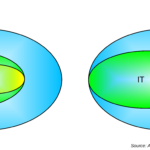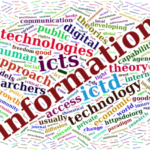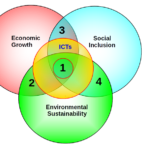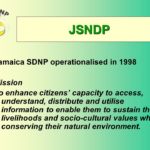This article was requested by the UK United Nations Association (http://www.una.org.uk/) and will be published in the next issue of their flagship publication, New World. According to UNA, New World has over 20,000 readers in over 100 countries. Thus, the article is customized for such readership.
The new century is just about to enter its teenage years, but it has already managed to bring forward dramatic changes that have affected most if not all of us. We can detect two visible trends by looking at these changes with an Information and Communications Technology (ICT) lens.
First, the spectacular growth in the use of mobile technologies and devices on a global scale. The latest estimates indicate that we now have over 6 billion mobile subscribers, and roughly 80% of them are in developing countries. Historians of technology have suggested that this is the first time in history that a new technology spreads so fast to so many people in so many countries. However, let us bear in mind that most of these users have access to primary mobile devices -as smartphones are diffusing at much slower rates and carry a heftier price and access tags.
The emergence of social media and the so-called Web 2.0 complements in good fashion the evolution of mobiles. Unlike the “old” Internet of the 1990s, social media empowers users to craft their own content and distribute it in real-time to billions of people on a global scale and at almost no cost. Recent data suggest that close to 1 billion people are on Facebook and over 500 million are using Twitter -certainly big numbers but somehow overshadowed by mobile access data.
Being that as it may, mobiles and social media are tightly linked in multiple ways. An example of this, and of the power of the new technologies to impact public space, is the recent “Arab Spring” revolutions which capitalized on them both, mobilized millions and triggered political change.
ICTs are not foreign to the MDGs. On the contrary, they are an integral part of the Millennium Agenda as reflected in MDG 8, Target 18, which calls for bringing access to ICTs for all in partnership with the private sector. If we again look at the impressive mobile access data, we can argue that we are well on the way to achieving such a target by 2015. But, if this is the case, what role can ICTs play in a post-2015 development agenda?
There are a couple of issues here. First, MDG Target 18 is totally focused on access to ICTs alone. While this in itself is a laudable goal, access to ICTs do not guarantee that all other MDGs will also be achieved – having access to a mobile device does not automatically bring forward better health and education or a new job. And secondly, ICTs are enablers of human development. They are thus a means to an end -and not a goal on themselves.
In this light, the real development value of the new ICT stems from its transformational potential. ICTs can provide new and innovative solutions to traditional development goals and priorities by increasing the efficiency and efficacy of processes and outputs and by radically changing how development assistance is provided. Nowadays, this is called innovation.
Let us go back to the world of mobile technologies to illustrate these points. Social innovators and entrepreneurs from developing countries are tackling human development priorities by developing applications and solutions that cater to the needs and demands of local communities. Being part of these communities, these innovators also have the trust of and credibility with local populations. They do not necessarily require external help to deliver – including applications on health, education, agriculture, and gender-based violence, among many others. Bottom-up innovation is taking root in many developing countries and some countries in Africa seem to be leading.
Take Ushahidi, a Kenyan initiative that emerged in 2007 with the purpose of monitoring and mapping post-election violence that affected the country back then. Capitalizing on the relatively high penetration of basic mobile phones, the initiative allowed people to use text messages (SMS) to report events which were then centralized and displayed into a (crisis) map in real-time. This form of crowd-sourcing -gathering user-provided information into one single platform using a simple technology- can also be used for many other purposes such as food/staple prices, reporting crime and potholes, and monitoring human rights abuses and corruption, etc. Today, Ushahidi or similar platforms are used in almost 100 countries.
The same goes for financial and banking services for the poor. M-Pesa, another Kenyan initiative, was able in 5 years to reach close to 20 million Kenyans, most of which did not have access to banking and/or financial services. The initiative itself does not involve any of the traditional banks who initially were quite skeptical about the financial viability of such a venture. M-Pesa is also being replicated in other countries, although with limited success; other initiatives such as The Better Than Cash Alliance promote similar goals on a global scale. Brazil’s own Bolsa Familia is also banking on the benefits of mobile banking.
These and many other innovations and innovators are changing the world by using old and new ICTs. The MDGs and the upcoming post-2015 development agenda should factor this in. The question today is not if ICTs should be part of development agendas in ways that transcend access. Rather, the question is how fast can we harness ICTs and innovations in developing countries to scale up ongoing initiatives, developed news ones to then be able to reach the billions who still today have little to no access to basic public and private services.
For additional examples on mobile innovation please see our publication Mobile Technologies and Empowerment: Enhancing Human Development Through Innovation and Participation, http://www.undpegov.org/mgov-primer.html
Raúl Zambrano
Global Lead/Senior Policy Advisor
ICT for Development and E-governance
United Nations Development Programme
http://www.undpegov.org
Raul has been working on ICT for Development for almost 25 years and has assisted over 80 developing countries in harnessing ICTs to enhance human development.





